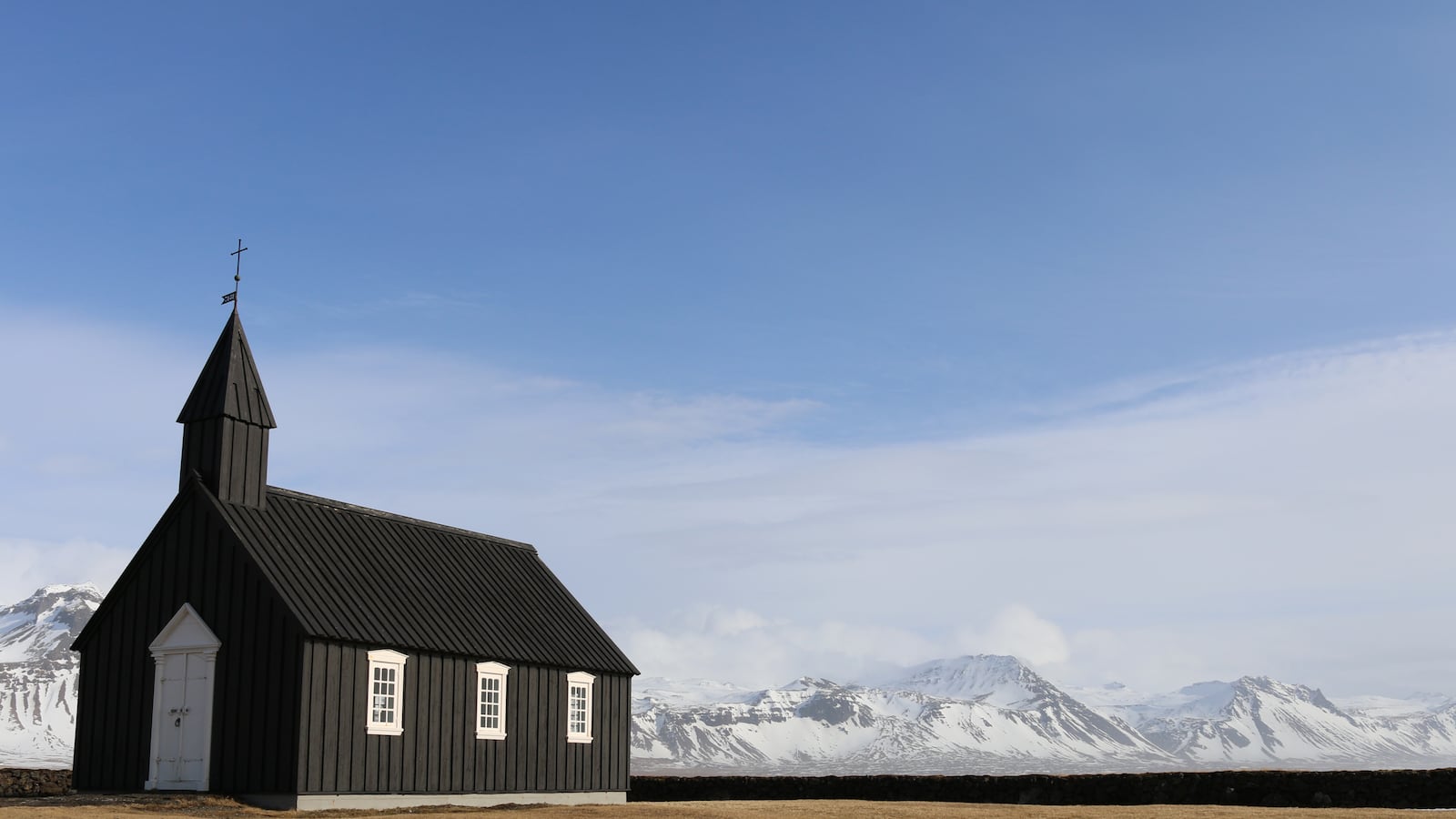I’m sitting under a lighthouse just outside Reykjavík watching the Northern Lights dance over Iceland’s capital city. The green hues are cascading across the sky like glowing curtains. It’s otherworldly.

I’m with the writer of the Lonely Planet travel guide to Iceland, the man who literally wrote the book on the country and who says he’s spent countless hours trying to explain the aurora borealis. “It’s indescribable,” he says. It would be hard to argue with that, were it not for the group of British students gazing at the lights a few feet away, one of whom has his own summation: “It looks like God farted.”
It was an odd, unexpected thing to say. And, it was kind of true. If nothing else, though, the whole exchange encapsulates Iceland, a place where every turn brings another mystifying natural wonder impossible to describe—a land of baffling, beautiful contradictions. How do you explain a place that’s both archaic and constantly changing? Where lava meets ice? That’s both lush with greenery and a frozen tundra? That’s electrifying and calming at the same time?
Iceland is not just a sprawling vista of untouched majesty. It’s a place with the population of a small town—315,000 citizens—that’s an actual country. It’s a battlefield hosting a centuries-long scrimmage between fire and ice, where unpredictable weather makes it seem like three seasons have passed in the course of four minutes, and where elves exist. For real (a little more on that later).
No place on Earth seems so alien, but perhaps no place is as pure a showcase for our planet’s most raw and active geological features. It’s indescribably beautiful. It’s really freaking weird. And it’s less than six hours away from the U.S.
Yes, you can fly from New York City to Reykjavík in less time than it usually takes to get from Manhattan to D.C. on a suffocating Megabus. And, providing you’re willing to spend an entire trip staring blankly every time someone says or writes down the name of a place you’re trying to go—Fáksrúðsfjörður doesn’t quite roll off the tongue—and that you have a little sense of adventure, it’s unexpectedly thrilling to fall asleep on an airplane in New York and wake up in a country so unforgiving and elemental that it feels almost as if you’ve traversed to another world.
The sense of adventure thing is important, though.
I like to think of myself as a low-maintenance person. Or as low-maintenance as a person who is annoyed when there is no more (free) greek yogurt for him to eat with his (free) double latte when he rolls into his Manhattan office at 10 a.m. But when the spritely owner of the charming Reykjavík design space Spark serves you trout cake for lunch—it is exactly what it sounds like—while you admire the sleek and cool works she has curated, or when a tour guide drives you to the top of the mountain only to surprise you with the information that you’ll be skiing down—that actually happened—you learn just how willing you are to embrace your adventurous spirit.
And for a proper visit to Iceland, that spirit is what you need to push yourself outside the comfortable confines of Reykjavík.
By no means is this a hit on the country’s bustling capital, a sleepless city deservedly proud of its ceaseless nightlife and burgeoning culture scene. It’s a stimulating place, where, in just three days, I was able to traverse its streets, end-to-end, countless times, stopping off at dozens of stimulating cafés and adorable shops. Kraum, a design store situated in Reykjavík’s oldest building, was my favorite treasure chest of wares.
Visiting during Iceland’s Fashion Week, I set up mini-residence at Harpa, a dazzling new concert hall and design center rising out of the city harbor (not to mention the post-crash economy), where I had a literal front-row seat to the ambitious creations from the country’s roster of burgeoning designers. (The cozy aesthetic of Farmer’s Market stood out most to me during the chilly week. Much of the other designs resembled, for better or worse, what you might imagine on hearing the phrase “Icelandic fashion.”)
But it’s outside Reykjavík, beyond the tourist-friendly geothermal spa Blue Lagoon that’s so heavily marketed to American travelers (and totally worth a dip), that you truly feel like you have stumbled upon a special place and are witnessing a side of our world that not many people get to experience.
A drive to the Snæfellsnes peninsula—seriously, these names—is a veritable coastline journey to the center of the Earth. In fact, Jules Verne’s protagonists found the passageway to their titular adventure here. The white caps on choppy ocean waters to the left point the way to the wind-swept sandy beaches, which in turn lead to fields of craggy lava formations that eventually climb toward towering mountains. A whale-watching trip out of the unassuming fishing village Grundarfjörður begins with jaded wisecracks about the recent controversial documentary Blackfish—God, I was obnoxious with those—and ends in astonished silence as the two dozen orcas circling your boat compete with the severe landscape for the title of "most breathtaking sight."
There’s this “fact” that it seems many Americans were taught by their third-grade teachers, who probably thought they were about to blow our little 8-year-old minds. “Greenland is actually full of ice,” they said, “and Iceland is actually green!” Then they stood in front of the chalkboard, smug and self-satisfied.
Well, the teachers were wrong. Dead wrong. There is so much freaking ice on Iceland. It’s cold and windy and snowy and covered with all kinds of wintry weather and precipitation. It’s, of course, absolutely gorgeous. But do not be fooled—the reason Iceland was named Iceland is because it is most definitely full of the stuff.

And nothing really compares to the sight of that ice contrasting with everything else the country has to offer, whether it’s the crystal-blue waters off the Snæfellsnes coast, the mossy hills dotted with countless waterfalls, or the glowing sunset sky during a dogsled excursion.
While dogsledding at sunset is a must, there are some things you should know. First of all, no one says “mush” when they want the dogs to go. At least, the guide who was controlling the eight huskies trotting around with my life in their hands didn’t. It’s really disappointing to sit on a dog sled and not have someone shout “mush,” like you’ve imagined all your life…or at least since seeing the 1995 animated film, Balto.
The other crucial thing no one talks about is the poop. Oh God, the poop. So much poop. If you ever thought dog sledding sounded glamorous, you were imagining an experience in which eight dogs did not spend the first 500 meters of the run taking turns pooping just inches from your face and then dragging the sled right over it. Dog sledding smells, people. But, oh, my, is it beautiful.
If there is anything that made an even more potent impression than the privilege of being escorted through nature at sunset by a team of beautiful dogs—and that’s a life-affirming experience, mind you—it’s the enthusiasm with which the guide spoke about his job, as if caring for these dogs, sharing their power, and guiding these sledding tours was a calling akin to joining the clergy.
And that really encapsulates the pure spirit of all Icelanders: an all-encompassing passion that permeates everything they do. They have an unrivaled warmth. Perhaps it’s because they need something to warm them up in all that frigid weather, or perhaps it’s just in their DNA. (Fewer than 200 people populate Iceland’s prisons.) Whatever the reason, it’s there.
I can’t tell you how many people told me the same story about how roadways have detoured around a single rock that elves are believed to reside in. Icelanders aren't crazy—they’re not running around saying that elves are living in trees baking Keebler cookies all day. But they respect the lore and the possibility of them enough to reroute highways, you know, just in case. And I can’t quantify how many people tried to convince me to go on bird-watching tours—my God, these people and their obsession with birds. But, I can recount all the people from this weird little country, a whole nation that is like the Cheers bar where everyone knows everyone’s name, who made a direct impact on my life.
There’s Greta Sigurðardóttir, owner of the charming B&B, Hotel Egilsen, that perks up sleepy Stykkishólmur, who makes the strongest case for this new idea of mine that everyone needs to have an Icelandic grandmother. There’s Embla Vigfúsdóttir, whose revelation that she not only stages pop-up dining experiences, like the whimsical “Order to Effect,” but that she also has a master’s degree in board-game design is a reminder of the necessity of infusing child-like wonder into everyday professionalism. And then there’s Siggi Bjarni, the guy who strapped on my snowshoes.
Siggi is the formidable young founder of South Iceland Adventures. I spent two days with Siggi, the first driving in some insane super Jeep to the top of Eyjafjallajökull, the volcano that erupted in 2010 and that lives beneath a gorgeous, though melting, glacier. The second day he drove us up part of Iceland’s famous Laugavegurinn hike, where he strapped on my snowshoes, led me on a trek to a remote (and precarious) canyon, and then dropped the bomb that I would be skiing back down the mountain—despite the fact that I have only been on skis twice before.
Oh, and he also changed my life.
Those two days taught me, a not-that-well-traveled person, that when you combine the spirit and passion of the people in a strange country with a trek through nature, conversations suddenly become transcendent. Excursions become the birthplace of new life philosophies. And your 26-year-old hiking leader becomes your spiritual guide, because everything he says is spoken with unquestionable earnestness and conviction. (It helps, of course, that it’s spoken while standing on top of a volcano literally above the clouds.)
I learned a lot about myself on that excursion, and from the trip as a whole. I learned that maybe I am an outdoorsman, or, at least, appreciate nature far more than the jaded city-boy personality I’ve crafted lets on. That in my quest for streamlining my life into an urban normality, I never quite learned the beauty of embracing things that are weird or uncomfortable. That I never really learned how to take a proper selfie. (Proof above.)
And I learned that there’s nothing in this world quite as beautiful as God’s fart.






